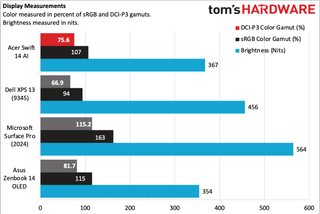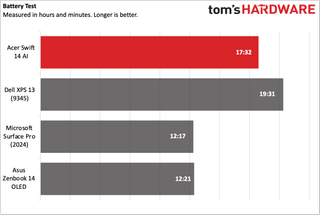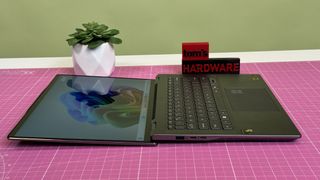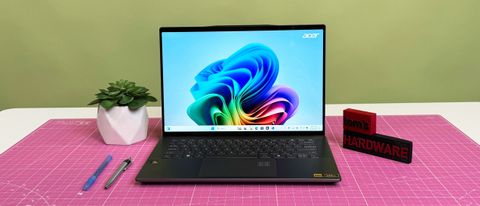Tom's Hardware Verdict
The Acer Swift 14 Ai is a capable laptop with a fast SSD and long battery life, but it's bulkier and less attractive than the competition and smothered in bloatware.
Pros
- +
Fast SSD
- +
Long battery life
- +
High-resolution webcam
- +
Two USB Type-A and Type-C ports
Cons
- -
Crunchy (yes, crunchy) touchpad
- -
Heavier than competition
- -
Way too much bloatware
- -
Weird AI indicator
Why you can trust Tom's Hardware
Not that there haven't been giant leaps in computing in the last few years or anything, but AI has become a bit of a buzzword, even among the best ultrabooks. So it’s no surprise that that's the case with the Acer Swift 14 AI ($1,199.99). The laptop's best features — long battery life, a crystal clear webcam, a fast SSD — are subsumed by AI branding. There's an AI icon on the lid, and an AI "indicator" on the touchpad.
Acer's take on the AI/Copilot Plus/Arm PC is thicker and heavier than some competitors, and doesn't have a ton of personality outside of really wanting AI to be cool. Which is a shame, because the laptop has redeeming factors, like having more ports than its rivals, which have opted to go as thin as possible.
This is a capable PC. If you want to make the jump to Windows on Arm, want lots of ports, and care a lot about the webcam, it will satisfy. But Acer still needs to work on the touchpad, should strip out a ton of bloatware, and focus more on making a great Windows laptop than an AI computer.
Design of the Acer Swift 14 AI
Acer desperately wants you to think about AI when you use its laptop. While the Swift 14 AI is actually quite plain, the company has peppered a few reminders that, yes, the Swift has Copilot and an NPU, and that makes it special. Unfortunately, those reminders also make little sense.
On the sturdy, metal lid, the dark gray material is punctuated only with an rainbow Acer logo and, on the opposite corner, a series of dots and lines. In materials sent to reviewers, this is referred to only as an "AI Icon." Sure, I guess.



With the lid open, the Swift 14 AI appears premium. The dark metal chassis feels solid, and there's not much of a bezel around the display. But on the touchpad, there's an "Activity indicator," a series of lines and dots. This illuminates when you launch Copilot or when you use Acer's AI software. I found this more annoying than anything else (for instance, Acer QuickPanel activates whenever you turn on the camera, illuminating the indicator).
Fine, I get it, you have AI. On the bright side, if you dig through the AcerSense software, you can disable the lighting. That being said, the setting didn't always stick for me.


There are a fair number of ports on the Swift 14 AI, likely because it's a bit thicker than some competing Snapdragon-based laptops. On the left side, you get a USB Type-A 3.2 Gen 1 port and a pair of USB 4 Type-C ports.The right side houses a second USB-A port and the headphone jack. Acer also includes a USB-C to HDMI dongle in the box.
The Swift 14 AI measures 12.7 x 9 x 0.72 inches and weighs 3.2 pounds. That's larger and heavier than the Dell XPS 13 (9345) at 11.63 x 7.84 x 0.6 inches and 2.62 pounds, which also has a Snapdragon X Elite, or the Microsoft Surface Pro which is 1.97 pounds before the keyboard. The Asus Zenbook 14 OLED, an Intel-based machine, is 2.82 pounds.
Acer Swift 14 AI Specifications
| Processor | Qualcomm Snapdragon X Elite X1E-78-100 |
|---|---|
| Graphics | Qualcomm Adreno (integrated) |
| NPU | Qualcomm Hexagon (45 TOPS) |
| Memory | 16GB LPDDR5x-8448 |
| Storage | 1TB PCIe Gen 4 SSD |
| Display | 14.5-inch, 2560 x 1600, 120 Hz, touch |
| Networking | Qualcomm FastConnect 7800 Wi-Fi 7, Bluetooth 5.4 |
| Ports | 2x USB 4 Type-C, 2x USB 3.2 Gen 1 Type-A, 3.5 mm headphone jack |
| Camera | 1440p webcam, IR |
| Battery | 75 WHr |
| Power Adapter | 65W USB Type-C |
| Operating System | Windows 11 Home |
| Dimensions (WxDxH) | 12.7 x 9 x 0.72 inches / 322.6 x 228.6 x 18.3 mm |
| Weight | 3.2 pounds (1.45 kg) |
| Price (as configured) | $1,199.99 |
Productivity Performance on the Acer Swift 14 AI
The Swift 14 AI is the latest laptop we've tested with a Qualcomm Snapdragon X Elite processor (specifically, the ever-so-elegantly named Snapdragon X Elite X1E-78-100). This laptop also comes with 16GB of RAM and 1TB of storage.
The chip in the Swift is a slight step below the Snapdragon X Elite X1E-80-100 we tested in the Dell XPS 13 (9345) and the Microsoft Surface Pro. The 78-100 doesn't support dual-core boost and has slower graphics, but still offers 12 cores. We also compared it to the Asus Zenbook 14 OLED with an Intel Core Ultra 7 155H and 32GB of RAM.




On Geekbench 6, the Swift 14 AI earned a single-core score of 2,452 and a multi-core score of 14,635. Both the Dell and the Surface outperformed it in single-core, but the three systems were more comparable in multi-core scores. The Swift 14 AI was on par with the Zenbook 14 OLED for single-core, but the Intel-powered machine trailed when it came to using multiple cores.
On our file transfer test, Acer was the fastest of the group, copying 25GB of files at a rate of 1,891.13 MBps. The slowest was the Surface Pro, at 1,001.16 MBps.
The Acer and the Dell came in neck and neck on Handbrake, transcoding 4K video to 1080p. It took the Acer 4 minutes and 46 seconds to complete the task. The Surface came in at 5:21 while the Zenbook took 6:17.
We stress test laptops by running Cinebench 2024 for ten runs. The Swift started at 714.57 before dipping down into the 690's. By the end, the system had recovered and was running as high as 724.37 before starting to show a dip by the end of the runs. According to HWInfo, (which now supports Snapdragon's Oryon processors in beta), the CPU ran at an average of 3.4 GHz and measured 68.62 degrees Celsius.
Display on the Acer Swift 14 AI
Acer put a 14.5-inch, 2560 x 1600 touch display with a 120 Hz on the Swift 14 AI. The display is colorful enough, and while I found it mostly bright enough in everyday use, competitors get brighter.
The trailer for Captain America: Brave New World looked fine on the screen — it showed off orange explosions and neon electric blue weapons, but the darker scenes didn't stand out as much as they do on some competitive laptops.

The Swift covers 75.6% of the DCI-P3 gamut (107% sRGB), beating the Dell XPS 13's base screen and effectively on par with the Zenbook 14 OLED. But the Swift measured just 367 nits, which was dimmer than the XPS 13 (456 nits), and the Surface Pro's display (564 nits, 115.2% DCI-P3) was the most impressive of the group, though you have to fork out more cash for it.
Keyboard and Touchpad on the Acer Swift 14 AI
The backlit keyboard on the Swift 14 AI is serviceable. Considering the Swift is thicker than its competition, I wish the travel were a bit deeper. That being said, the keys are snappy, and I hit 123 words per minute on the monkeytype typing test. Despite the high speeds, I was slightly less accurate than usual at 97%.


The trackpad, however, is abhorrent. Nevermind the AI drawing, which doesn't affect functionality; it just feels bad to click on. The best way I can describe it is that it's crunchy in the center, as if I was hitting something underneath the touchpad (it even made a sound, as if someone in rainboots stepped in a pile of leaves). It's not as bad on the edges, but there it still feels cheap.
Audio on the Acer Swift 14 AI
The speakers get comfortably loud enough to fill a room. Hozier's voice in "Nobody's Soldier" was clear, as were the drums, but the guitar was a bit muddy and the bass was nowhere to be found. In the DTS software on board, I was able to use bass boost to get a better hint of the low-end, as well as make some tweaks to the EQ that improved the sound.
Upgradeability on the Acer Swift 14 AI
There are 10 Torx screws on the outside of the Swift 14 AI. They're all the same length, thankfully. That's the easy part.



Once you take the lid off, you'll see that most of the key components are soldered to the motherboard. This includes the RAM and the Wi-Fi card. The battery can be removed, and you can replace the SSD, though you have to explore to find it. The drive is located underneath a ribbon cable attaching the motherboard to a smaller board on the right side of the notebook for additional ports. You'll have to flip up a holding latch (you can use a fingernail or a small pry tool) and remove a ribbon cable, and then you can get the standard M.2 2280 SSD.
There are oddities in the case design. For instance, there's plastic that looks like it could hold a CMOS battery, though it's among some empty space to the right of the battery. It makes me wonder if Acer could've fit a better battery in here, or if it re-used an older chassis.
Battery Life on the Acer Swift 14 AI
Like many of the other other Copilot Plus PCs running on Qualcomm's Snapdragon X platforms, the Acer Swift 14 AI has impressive battery life. It ran for 17 hours and 32 minutes on our battery test, constantly browsing websites, running OpenGL tests, and streaming video with brightness set at 150 nits. The Dell XPS 13, with a lower-resolution display, went even longer at 19:31.

But the Swift beat out both the Surface Pro (12:17, with an OLED screen) and the Intel-based Asus Zenbook 14 OLED (12:21).
Heat on the Acer Swift 14 AI
During our Cinebench stress test, the Swift 14 AI got toasty, but not unusable. The center of the keyboard climbed to 104 degrees Fahrenheit (40 C), while the touchpad was cooler at 90 F (32.22 C). The hottest spot on the bottom, near the exhaust, hit 114.6 F (45.88 C).
Webcam on the Acer Swift 14 AI
Acer has a high-resolution 1440p webcam on the Swift 14 AI. When one of Windows' marquee AI features is Windows Studio effects, a high-end camera to show that off makes sense.
And the camera is solid. In a challenging situation next to a window, it balanced out the light as best as it could (one side of my face is brighter than the other, sure, but that's how it was in real life). My red shirt was slightly more vivid than in real life, and I could see plenty of details, like the bags under my eyes after a sleepless night and the titles of books on a shelf behind me.
Acer QuickPanel, with fast access to Windows Studio Effects (it's effectively a huge shortcut), pops up every time you open the camera. It's annoying, and I wish there were more obvious ways to keep it from turning on so often in the first place.
Software and Warranty on the Acer Swift 14 AI
Acer puts way too much software and other bloat on the Swift 14 AI. There's a ton of Acer-branded apps, including Jumpstart, which just links to Acer's website (which seems unnecessary, I can go there if I want); QuickPanel to get access to camera settings; User Sensing, which lets you lock the screen when you walk away or make sure you're at a safe distance; and AcerSense, which has system usage settings and system stats.
But Acer also fills the Start Menu with junk, like small games like Amazing Slots, Solitaire, Elvenar, and Forge of Empires, some of which open in the web browser. There are also links to Booking.com in both the taskbar and the Edge browser bookmarks folder. There's also GT Booster AIFlow, which shows which apps are connecting to the internet and provides statistics about your network.
As of this writing, Microsoft only includes Windows 11's Copilot+ features — such as Windows Studio Effects, Cocreate images, and live captions — with Snapdragon X laptops like the Swift 14 AI. They're set to come to select AMD and Intel laptops soon.
Acer sells the Swift 14 AI with a 1-year warranty.
Bottom Line
The Acer Swift 14 AI is a capable Copilot+ laptop with long battery life; a high-quality, high-resolution webcam; and a fast SSD. It's not as attractive or thin as some competing Snapdragon machines, and the touchpad feels unsatisfying. While AI is still a minimal part of the Windows experience, it's a big part of weird icons peperring this laptop.

Perhaps the best excuse for the Swift's relative chunkiness is that it has both two USB Type-C ports and two USB Type-A ports, letting you attach plenty of peripherals (assuming they all work with Windows on Arm). There are other positives, too, like an excellent webcam for a laptop, and a speedy SSD.
At $1,199.99 for the sole configuration, however, this is a bit pricey. The Intel Core Ultra-based Asus Zenbook 14 OLED with 32GB of RAM, a 1TB SSD, and a 2880 x 1800 touchscreen was $1,299.99 when we reviewed it, and additional configurations have gotten even cheaper. If you're willing to drop storage and screen resolution, the Dell XPS 13 (9345) is starting as low as $999.99 with a more powerful variant of the Snapdragon X Elite.
If you want some bells and whistles, like a 120 Hz display and tons of ports, the Swift 14 may be for you. But if you prefer something sleek and thin, you can find more power and the longevity in laptops that feel a bit more polished.
MORE: How to Buy a Gaming Laptop
MORE: Best Gaming PCs
Andrew E. Freedman is a senior editor at Tom's Hardware focusing on laptops, desktops and gaming. He also keeps up with the latest news. A lover of all things gaming and tech, his previous work has shown up in Tom's Guide, Laptop Mag, Kotaku, PCMag and Complex, among others. Follow him on Threads @FreedmanAE and Mastodon @FreedmanAE.mastodon.social.
-
NinoPino @AuthorThere is a little error in : "The Dell XPS 13, with a lower-resolution display, went even longer at 17:32", should be 19:31.Reply -
Notton Seeing as the trackpad is behind the battery, and the battery is held in by screws, maybe do a followup tear down to see what is making it crunch?Reply -
Hooda Thunkett Please tell me I wasn't the only one to read the headline and think this computer had an indicator for Weird Al, not an unusual A.I. indicator.Reply
